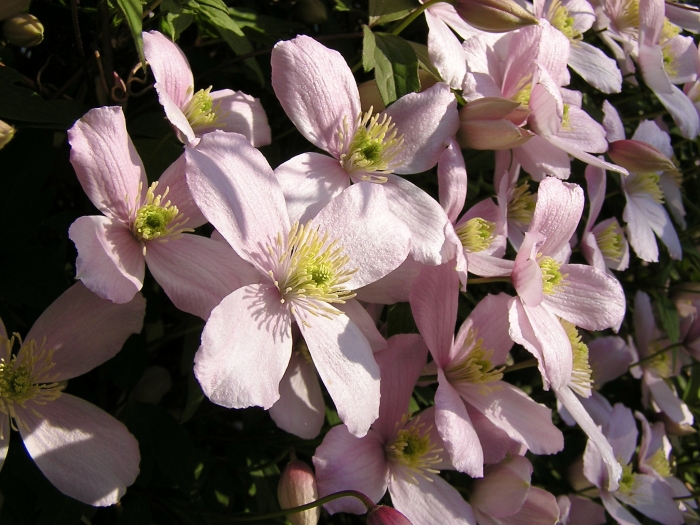Himalayan Clematis
(Clematis montana)
Himalayan Clematis (Clematis montana)
/
/

NasserHalaweh
CC BY-SA 4.0
Image By:
NasserHalaweh
Recorded By:
Copyright:
CC BY-SA 4.0
Copyright Notice:
Photo by: NasserHalaweh | License Type: CC BY-SA 4.0 | License URL: https://creativecommons.org/licenses/by-sa/4.0 | Uploader: NasserHalaweh | Publisher: Wikimedia Commons | Title: Ranunculaceae_Clematis_montana_1.2.jpg | Notes: Transferred from Flickr via #flickr2commons |










































Estimated Native Range
Summary
Clematis montana, commonly known as Himalayan Clematis, is a deciduous perennial vine. It is native to the montane regions of the Himalayas to Taiwan, where it thrives in forests, forest margins, and scrub areas. This species can reach a length of up to 12 meters (39 feet), and it is known for its vigorous climbing habit. Clematis montana blooms profusely in late spring, with a flowering period of about four weeks. The flowers are typically white or pink, four-petalled, and have prominent yellow anthers, creating a striking display against the foliage. The plant is particularly attractive to bees, butterflies, and hummingbirds, which are drawn to its nectar-rich flowers.
In cultivation, Himalayan Clematis is valued for its ability to cover unsightly structures quickly, making it an excellent choice for trellises, arbors, and fences. It prefers full sun to part shade and requires medium amounts of water, along with well-draining soil. While it can tolerate a range of soil types, it performs best in soils that are neutral to slightly alkaline. Gardeners should be aware that Clematis montana can become quite large and may require pruning to keep it under control. It is generally disease-resistant but can be affected by clematis wilt, a fungal disease that causes sudden wilting and death of stems.CC BY-SA 4.0
In cultivation, Himalayan Clematis is valued for its ability to cover unsightly structures quickly, making it an excellent choice for trellises, arbors, and fences. It prefers full sun to part shade and requires medium amounts of water, along with well-draining soil. While it can tolerate a range of soil types, it performs best in soils that are neutral to slightly alkaline. Gardeners should be aware that Clematis montana can become quite large and may require pruning to keep it under control. It is generally disease-resistant but can be affected by clematis wilt, a fungal disease that causes sudden wilting and death of stems.CC BY-SA 4.0
Plant Description
- Plant Type: Vines
- Height: 15-20 feet
- Width: 8-16 feet
- Growth Rate: Rapid
- Flower Color: Pink, Purple, White
- Flowering Season: Summer
- Leaf Retention: Deciduous
Growth Requirements
- Sun: Full Sun
- Water: Medium
- Drainage: Medium
Common Uses
Bee Garden, Bird Garden, Border Plant, Butterfly Garden, Deer Resistant, Fragrant, Hummingbird Garden, Low Maintenance, Rabbit Resistant, Showy Flowers
Natural Habitat
Montane regions of the Himalayas, forests, forest margins, and scrub areas
Other Names
Common Names: Mountain Clematis, Bergbosrank, 繡球藤, Xiu Qiu Teng
Scientific Names: , Clematis montana, Clematis montana var. montana, Clematis montana var. pubescens, Clematis montana var. anemoniflora, Clematis montana var. brevipedunculata, Clematis montana var. lilacina, Clematis montana var. obtusisepala, Clematis montana var. uniflora,
GBIF Accepted Name: Clematis montana Buch.-Ham. ex DC.